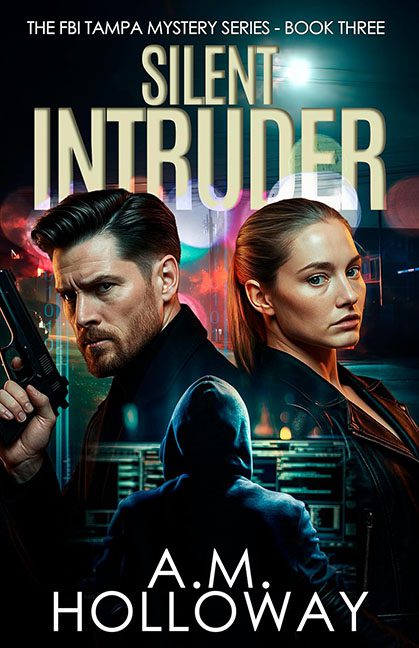
Some covers reveal their crimes instantly. Others lurk in the digital shadows, looking deceptively competent until you zoom in, look longer, or—heaven forbid—turn on your designer brain. Silent Intruder is the latter: a cover that sits quietly in the corner pretending to be professional, polished, genre-appropriate… until you catch the glint of an oddly placed light flare or a suspiciously familiar hoodie silhouette and realize you’re dealing with a thriller-themed wolf in very cheap sheep’s clothing.
At first glance, you think, “Alright, this is fine.” You’ve got serious FBI agents, strong lighting, bold typography. But look again. No, deeper. That’s when the design starts peeling apart like layers of poorly integrated Photoshop files. The man and woman aren’t sharing a scene—they’re on a speed date between mismatched lighting setups. His shadows are brooding and directional; hers are soft and studio-lit. They’re not partners in the case—they’re two stock models fighting for dominance in a thumbnail-sized rectangle.
And then there’s the hacker. Ah yes, the classic “man in hoodie” archetype—the most overused, exhausted, corporate-stock-photo cliché in cybercrime history. He’s crouched in the foreground like an NPC who forgot his blocking and wandered into the poster. His edges are as crisp as an iron-on patch, and he blends with the background about as well as a Minecraft character dropped into The Matrix. Nothing says “I know nothing about hacking but want you to think I do” like the hoodie silhouette with glowing blue accents, so bravo, I guess.
Once your eyes recover from that, you realize the background is not a place—it’s a digital limbo. A soup of city lights, water reflections, gloomy gradients, maybe hydro wires? Maybe a spotlight? Possibly a moon? Or maybe the graphic designer just started layering glow effects and never stopped. The composition is so disjointed it could be anywhere—an alley, a rooftop, a marina, a data center, or a low-budget planetarium. Your guess is as good as the designer’s, and I promise their guess wasn’t good.
But the real chaos lives in the middle of the cover—right between the gun, the models, and the bargain-bin cyber villain. Look at those glowing orbs, eight of them by your count, all floating like lost souls of abandoned design drafts. Add in the falling strings of ones and zeroes—because apparently nothing says “technology” like decades-old Matrix fan art—and the cover turns into a cluttered digital salad. There are so many overlays fighting for attention that the only true silent intruder here is coherent composition.
Then you reach the title. Clean font, at first glance. Legible. Simple. But wait—what’s that bleeding through it? Ah yes. Light dots. Lens flares. Stray particles of illumination drifting across the text like dandruff on a dark jacket. Even the title couldn’t escape the swarm of glowing nonsense raining down over the entire design like cyberpunk glitter.
And the irony? The longer you look, the more it feels like this cover is almost good. The ingredients want to be professional. They’re trying their best. But they’re all from different kitchens, different meals, different cooking shows entirely. This is what happens when you take individually solid pieces and merge them without a plan: a digital chimera that pretends to be sleek but reveals its seams the moment you stop squinting.
Final verdict: Silent Intruder is the thriller cover equivalent of a counterfeit luxury bag—convincing from afar, but up close, the stitching is chaos, the material is shiny plastic, and the logo is spelled just slightly wrong. It masquerades as polished, but in truth, it’s a design horror wearing a hoodie, leaking binary code, and hoping you don’t look too closely.
